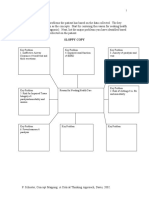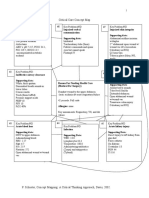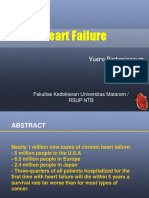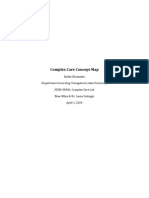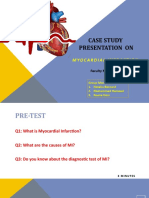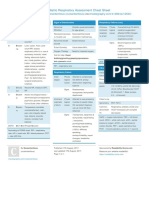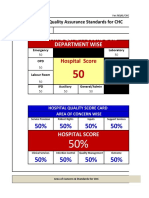Concept Map CC
Uploaded by
api-546473008Concept Map CC
Uploaded by
api-5464730081
Key Problem Key Problem Key Problem
Excessive Fluid Impaired Gas Ineffective Breathing
Volume Exchange Pattern
Key Problem
Key Problem Reason for Needing Health Care
Imbalanced nutrition
Decreased Cardiac ST- segment elevation myocardial
Tissue Perfusion infarction (STEMI)
Key Problem Key Problem Key Problem
Decreased Cardiac Ineffective peripheral Impaired verbal
Output Tissue Perfusion communication
P. Schuster, Concept Mapping: A Critical Thinking Approach, Davis, 2002.
2
Data don’t
know where
to put in
boxes:
#7 Key Problem/ND #2 Key Problems/ND #1 Key Problem/ND
Excessive fluid volume Impaired Gas Exchange Ineffective Breathing
Supporting data: Pattern
Dyspnea Supporting data: Supporting data:
Generalized 1+ non pitting Intubated Intubated
edema AC vent setting (rate 18) AC vent setting (rate 18)
FIO2 40 ABG’s pH 7.31, pCO2 46.6,
ABG’s pH 7.31, pCO2 46.6, HCO3 16
HCO3 16 Uncompensated respiratory
Uncompensated respiratory acidosis
acidosis dizziness/syncope/dyspnea
prior to admission
#3 Key Problem/ND:
Key Problem/ND
Decreased Cardiac Tissue #8
Imbalanced nutrition:
perfusion
Less than body
Reason For Needing Health Care requirements
Supporting data:
(Medical Dx/ Surgery) Supporting data:
EKG showing ST elevation
ST- segment elevation myocardial NPO diet
elevated troponin (9.470)
infarction (STEMI) Hx of diabetes (glucose 206)
blockage of proximal left
70 yo male, Full code Albumin 2.6L
circumflex artery
Hypoactive bowel sounds
chest pain
Key assessment- respiratory & cardiac
Allergies- penicillin’s (rash)
#4 Key Problem/ND #5 Key Problem/ND #6 Key Problem/ND
Decreased Cardiac Output Ineffective peripheral tissue Impaired Verbal
perfusion communication
Supporting data:
Hx of hypertension Supporting data: Supporting data:
Stent placement Blockage of proximal left Intubated
Troponin 9.470 High circumflex artery Propofol IV (sedation)
Aspirin NG Uncompensated respiratory Lorazepam IV (sedation)
Plavix NG acidosis
ABG’s pH 7.31, pCO2 46.6,
HCO3 16
AC Vent setting
Problem #1: Ineffective Breathing Pattern
General Goal: Maintain rate of 18 on A/C/ tachypnea free
P. Schuster, Concept Mapping: A Critical Thinking Approach, Davis, 2002.
3
Predicted Behavioral Outcome Objective (s): The patient will…… have a breathing rate that matches A/C
of 18
Nursing Interventions Patient Responses
1. Auscultation of breath sounds 1. Lung sounds clear
2. Ensure proper positioning of 2. Tube secure, 22cm at lip,
tube midline
3. Monitor Respiration rate 3. Respirations 18 AC
4. Insure proper positioning of 4. Patient supine, HOB 30
patient in bed degrees
5. Keep ETT free of secretions 5. ETT free of secretions
6. Monitor skin color 6. Skin pink, warm, dry
7. Monitor oxygen saturation 7. Oxygen 98%
Evaluation of outcome objectives: outcome met for shift, breathing rate remained 18 on AC
Problem #2: Impaired Gas Exchange
General Goal: Increased Gas Exchange
Predicted Behavioral Outcome Objective (s): The patient will…… have ABG’s within normal
limits/maintain oxygen saturations at normal levels
Nursing Interventions Patient Responses
1. assess respiratory rate 1. Respiratory rate 18 on AC
2. auscultate lungs for adventitious
sounds 2. Lungs clear and equal bilaterally
3. Monitor oxygen saturation 3. Oxygen 98%
4. Monitor ABG’s 4. ABG’s WNL during shift
5. Elevate head of bed to 30 degrees 5. HOB at 30 degrees
6. assess skin for cyanosis/pallor 6. Skin warm, dry, pink
Evaluation of outcome objectives: outcome met for shift, ABG’s WNL, oxygen saturations at normal
levels
P. Schuster, Concept Mapping: A Critical Thinking Approach, Davis, 2002.
4
Problem #3: Decreased Cardiac tissue perfusion
General Goal: Have absence of arrhythmias
Predicted Behavioral Outcome Objective (s): The patient will…… maintain vitals within normal range
Nursing Interventions Patient Responses
1. Check bilateral pulses for
Quality and regularity 1. Pulses regular/equal in all extrems
2. monitor EKG for irregularities 2. EKG NSR
3. monitor pulse oximetry 3. Oxygen 98%
4. assess for murmurs 4. No murmurs present
5. administer cardiac meds as ordered 5. Cardiac meds administered
6. have emergency/defib equipment 6. Crash cart ready
readily available 7. Troponin levels elevated
7.monitor troponin
Evaluation of outcome objectives:all vitals WNL, troponin levels were continued to be monitored
Problem #4: Decreased Cardiac Output
General Goal: Maintain Adequate Cardiac Output
Predicted Behavioral Outcome Objective (s): The patient will…… maintain normal vital signs and have
improved troponin level
Nursing Interventions Patient Responses
1. monitor EKG 1.EKG NSR
2. Monitor Tropine 2. Troponin levels elevated (9.470)
3. assess VS 3. VS WNL
4. Auscultate heart sounds 4. S1&S2 present, absent of murmurs
5. monitor HR/rhythm 5. HR WNL/regular
6. Measure Cardiac output 6. Adequate cardiac output
7. Maintain Iv access 7. IV’s Patent
Evaluation of outcome objectives: vitals WNL, troponin levels elevated
P. Schuster, Concept Mapping: A Critical Thinking Approach, Davis, 2002.
5
Problem #5: Ineffective peripheral tissue perfusion
General Goal: Maintain adequate tissue perfusion
Predicted Behavioral Outcome Objective (s): The patient will…… have warm and dry skin, balanced I&O,
absence of edema
on the day of care.
Nursing Interventions Patient Responses
1. Inspect for cyanosis 1. Skin pink, warm, dry
2. Monitor respirations 2. Respirations 18 on vent AC
3. monitor I&O 3. Input matched output
4. Assess GI function 4. Bowel sounds hypoactive
5. Monitor electrolytes 5. Electrolytes WNL (exclude calcium
low)
6. Monitor ABG’s 6. ABG’s WNL
Evaluation of outcome objectives: all outcomes met except for calcium being slightly low and generalized
1+ non pitting edema assessed
Problem # 6: Impaired Verbal Communication
General Goal: Effective communication
Predicted Behavioral Outcome Objective (s): The patient will…… respond with appropriate non verbal
behaviors such as positive dolls eyes
Nursing Interventions Patient Responses
1. Assess environmental factors 1. Lights dimmed, quiet room
2. pay attention to nonverbal cues 2. Patient remained stable
3. Assess ETT tube/cuff pressure 3. Proper placement and patent
4. Neurological Assessment 4. Sedated
5. Involve family in plan of care as
much as possible 5. Plan of care discussed with family
6. Ensure sedation drugs are administered
as ordered 6. Propofol and Lorazepam given
Evaluation of outcome objectives: appropriate nonverbal cues assessed
P. Schuster, Concept Mapping: A Critical Thinking Approach, Davis, 2002.
6
Problem #7: Excessive fluid volume
General Goal: Balanced fluid Volume
Predicted Behavioral Outcome Objective (s): The patient will…… have decreased generalized edema,
balanced I&O, serum lab values within normal limits
Nursing Interventions Patient Responses
1. Assess BP/edema 1. Generalized edema/ BP normal
2. Assess urine color 2. Yellow/clear
3. Assess renal function 3. Kidneys functioning properly
4. Assess Foley/provide care 4. Foley proper placement/patent
5. Assess IV sites/provide care 5. IV sites patent free of phlebitis
6. Administer IV fluids per order 6. IV fluids given per order
Evaluation of outcome objectives: balanced I&O, calcium low, generalized 1+ non pitting edema
Problem #8: Imbalanced Nutrition: less than body requirements
General Goal: Improved Nutritional Status
Predicted Behavioral Outcome Objective (s): The patient will…… have normoactive bowel sounds and lab
values within normal limits
Nursing Interventions Patient Responses
1. Assess GI status 1. Hypoactive bowel sounds
2. Assess NG residual q4h 2. Clear/ yellow
3. Monitor serum labs 3. Hypocalcemia
4. Assess daily weights 4. Patient of proper weight
5. provide good oral hygiene 5. Oral hygiene performed
6. Ensure proper positioning in bed 6. Patient supine HOB 30 degrees
Evaluation of outcome objectives: hypoactive bowel sounds, hypocalcemia
P. Schuster, Concept Mapping: A Critical Thinking Approach, Davis, 2002.
7
P. Schuster, Concept Mapping: A Critical Thinking Approach, Davis, 2002.
You might also like
- Assessment & Reasoning Cardiac System: Suggested Cardiac Nursing Assessment Skills To Be Demonstrated100% (1)Assessment & Reasoning Cardiac System: Suggested Cardiac Nursing Assessment Skills To Be Demonstrated8 pages
- Breathe Well, Be Well: A Program to Relieve Stress, Anxiety, Asthma, Hypertension, Migraine, and Other Disorders for Better HealthFrom EverandBreathe Well, Be Well: A Program to Relieve Stress, Anxiety, Asthma, Hypertension, Migraine, and Other Disorders for Better Health5/5 (1)
- Assessment and Concept Map Care Plan For Critical Care PatientNo ratings yetAssessment and Concept Map Care Plan For Critical Care Patient11 pages
- Assessment and Concept Map Care Plan: Joseph GorospeNo ratings yetAssessment and Concept Map Care Plan: Joseph Gorospe5 pages
- Assessment and Concept Map Care Plan Critical Care PatientNo ratings yetAssessment and Concept Map Care Plan Critical Care Patient8 pages
- Cirrhosis: Primary Concept Nutrition Interrelated Concepts (In Order of Emphasis)100% (2)Cirrhosis: Primary Concept Nutrition Interrelated Concepts (In Order of Emphasis)12 pages
- Asian Hospital and Medical Center Sample Concept Care Mapping Step 1-5 By: Pamela Mchugh SchusterNo ratings yetAsian Hospital and Medical Center Sample Concept Care Mapping Step 1-5 By: Pamela Mchugh Schuster3 pages
- Delayed Surgical Recovery Risk For Infection Impaired Gas ExchangeNo ratings yetDelayed Surgical Recovery Risk For Infection Impaired Gas Exchange9 pages
- Concept Map Template - Andreanna TocickiNo ratings yetConcept Map Template - Andreanna Tocicki5 pages
- Approach To Patient With Dyspnea & Ankle Swellling: Dr. Mudhafar Barzani MBCHB, DM, PHD, FRCP Ass. Prof. in CardiologyNo ratings yetApproach To Patient With Dyspnea & Ankle Swellling: Dr. Mudhafar Barzani MBCHB, DM, PHD, FRCP Ass. Prof. in Cardiology55 pages
- Critical Care Concept Map Template Final 2No ratings yetCritical Care Concept Map Template Final 26 pages
- NURS 3105 Foundations of Patient-Centered Care: Oxygenation: Cardiac ComponentNo ratings yetNURS 3105 Foundations of Patient-Centered Care: Oxygenation: Cardiac Component14 pages
- Group 2B: A Pulmonary Histoplasmosis CaseNo ratings yetGroup 2B: A Pulmonary Histoplasmosis Case58 pages
- Paediatric Respiratory Assessment Cheat Sheet: by ViaNo ratings yetPaediatric Respiratory Assessment Cheat Sheet: by Via1 page
- Multiple-Choice Questions Cardiology Questions For (UK) : The MRCP ExaminationNo ratings yetMultiple-Choice Questions Cardiology Questions For (UK) : The MRCP Examination6 pages
- An Introduction To Syntax: by Anmol ArzooNo ratings yetAn Introduction To Syntax: by Anmol Arzoo12 pages
- Clinical Nutrition: A.M. Navarro, M.A. Martinez-Gonzalez, A. Gea, R. Ramallal, M. Ruiz-Canela, E. ToledoNo ratings yetClinical Nutrition: A.M. Navarro, M.A. Martinez-Gonzalez, A. Gea, R. Ramallal, M. Ruiz-Canela, E. Toledo9 pages
- Hematological Anatomy, Physiology and Assessment: This Course Has Been Awarded One (1.0) Contact HourNo ratings yetHematological Anatomy, Physiology and Assessment: This Course Has Been Awarded One (1.0) Contact Hour19 pages
- Responsibility 1-Practices in Accordance With Legal Principles and The Code of Ethics in Making Personal and Professional JudgmentNo ratings yetResponsibility 1-Practices in Accordance With Legal Principles and The Code of Ethics in Making Personal and Professional Judgment13 pages
- MICROBIOLOGY - INTRODUCTION TO MICROBIOLOGY PT1No ratings yetMICROBIOLOGY - INTRODUCTION TO MICROBIOLOGY PT14 pages
- Cryolipolysis Body Slimming Machine Nbw-c132-User Manual100% (1)Cryolipolysis Body Slimming Machine Nbw-c132-User Manual22 pages
- Customized NQAS Checklist For Non FRU CHC of OdishaNo ratings yetCustomized NQAS Checklist For Non FRU CHC of Odisha130 pages
- Automated Plant Disease Analysis (APDA) Performance Comparison of MachineNo ratings yetAutomated Plant Disease Analysis (APDA) Performance Comparison of Machine6 pages
- Estimating The Primary Etiologic Agents in RecreationalNo ratings yetEstimating The Primary Etiologic Agents in Recreational12 pages
- The Dual Impact of Artificial Intelligence in Healthcare: Balancing Advancements With Ethical and Operational ChallengesNo ratings yetThe Dual Impact of Artificial Intelligence in Healthcare: Balancing Advancements With Ethical and Operational Challenges11 pages
- 2023 Directory of Euroqol PHD Network Members: Offer A Programme of Activities To Support Their Career DevelopmentNo ratings yet2023 Directory of Euroqol PHD Network Members: Offer A Programme of Activities To Support Their Career Development36 pages
- Queenie Rose Domingo - Drug Study (Silver Sulfadiazine)No ratings yetQueenie Rose Domingo - Drug Study (Silver Sulfadiazine)1 page
- Assessment & Reasoning Cardiac System: Suggested Cardiac Nursing Assessment Skills To Be DemonstratedAssessment & Reasoning Cardiac System: Suggested Cardiac Nursing Assessment Skills To Be Demonstrated
- Breathe Well, Be Well: A Program to Relieve Stress, Anxiety, Asthma, Hypertension, Migraine, and Other Disorders for Better HealthFrom EverandBreathe Well, Be Well: A Program to Relieve Stress, Anxiety, Asthma, Hypertension, Migraine, and Other Disorders for Better Health
- Assessment and Concept Map Care Plan For Critical Care PatientAssessment and Concept Map Care Plan For Critical Care Patient
- Assessment and Concept Map Care Plan: Joseph GorospeAssessment and Concept Map Care Plan: Joseph Gorospe
- Assessment and Concept Map Care Plan Critical Care PatientAssessment and Concept Map Care Plan Critical Care Patient
- Cirrhosis: Primary Concept Nutrition Interrelated Concepts (In Order of Emphasis)Cirrhosis: Primary Concept Nutrition Interrelated Concepts (In Order of Emphasis)
- Asian Hospital and Medical Center Sample Concept Care Mapping Step 1-5 By: Pamela Mchugh SchusterAsian Hospital and Medical Center Sample Concept Care Mapping Step 1-5 By: Pamela Mchugh Schuster
- Delayed Surgical Recovery Risk For Infection Impaired Gas ExchangeDelayed Surgical Recovery Risk For Infection Impaired Gas Exchange
- Approach To Patient With Dyspnea & Ankle Swellling: Dr. Mudhafar Barzani MBCHB, DM, PHD, FRCP Ass. Prof. in CardiologyApproach To Patient With Dyspnea & Ankle Swellling: Dr. Mudhafar Barzani MBCHB, DM, PHD, FRCP Ass. Prof. in Cardiology
- NURS 3105 Foundations of Patient-Centered Care: Oxygenation: Cardiac ComponentNURS 3105 Foundations of Patient-Centered Care: Oxygenation: Cardiac Component
- Paediatric Respiratory Assessment Cheat Sheet: by ViaPaediatric Respiratory Assessment Cheat Sheet: by Via
- Multiple-Choice Questions Cardiology Questions For (UK) : The MRCP ExaminationMultiple-Choice Questions Cardiology Questions For (UK) : The MRCP Examination
- Clinical Nutrition: A.M. Navarro, M.A. Martinez-Gonzalez, A. Gea, R. Ramallal, M. Ruiz-Canela, E. ToledoClinical Nutrition: A.M. Navarro, M.A. Martinez-Gonzalez, A. Gea, R. Ramallal, M. Ruiz-Canela, E. Toledo
- Hematological Anatomy, Physiology and Assessment: This Course Has Been Awarded One (1.0) Contact HourHematological Anatomy, Physiology and Assessment: This Course Has Been Awarded One (1.0) Contact Hour
- Responsibility 1-Practices in Accordance With Legal Principles and The Code of Ethics in Making Personal and Professional JudgmentResponsibility 1-Practices in Accordance With Legal Principles and The Code of Ethics in Making Personal and Professional Judgment
- Cryolipolysis Body Slimming Machine Nbw-c132-User ManualCryolipolysis Body Slimming Machine Nbw-c132-User Manual
- Customized NQAS Checklist For Non FRU CHC of OdishaCustomized NQAS Checklist For Non FRU CHC of Odisha
- Automated Plant Disease Analysis (APDA) Performance Comparison of MachineAutomated Plant Disease Analysis (APDA) Performance Comparison of Machine
- Estimating The Primary Etiologic Agents in RecreationalEstimating The Primary Etiologic Agents in Recreational
- The Dual Impact of Artificial Intelligence in Healthcare: Balancing Advancements With Ethical and Operational ChallengesThe Dual Impact of Artificial Intelligence in Healthcare: Balancing Advancements With Ethical and Operational Challenges
- 2023 Directory of Euroqol PHD Network Members: Offer A Programme of Activities To Support Their Career Development2023 Directory of Euroqol PHD Network Members: Offer A Programme of Activities To Support Their Career Development
- Queenie Rose Domingo - Drug Study (Silver Sulfadiazine)Queenie Rose Domingo - Drug Study (Silver Sulfadiazine)










